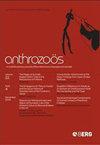Assessing Attendance Frequency and Duration at a Drop-In Animal Visitation Program Among First-Semester University Students Separated From Their Pets
IF 2.3
2区 农林科学
Q2 SOCIOLOGY
引用次数: 0
Abstract
ABSTRACTAnxiety and stress among incoming university students are associated with higher rates of mental health disorders and decreased academic success. One approach universities employ to prevent these problems is the implementation of Animal Visitation Programs (AVPs). While efficacy trials suggest positive effects, little is known about students’ program uptake (e.g., attendance frequency and duration) or students’ characteristics (e.g., current mood and past mental health, pet ownership, and pet separation anxiety) that shape program uptake. This study identified student characteristics that predicted AVP uptake in a subsample (n = 209) of randomly selected first-year university students (n = 2,000) who were screened for pet ownership and randomly assigned to attend a semester-long drop-in AVP program (i.e., seven 2-hour sessions) (n = 105) with registered therapy dogs or a waitlist control group (n = 104). Using logistic and multiple regression modeling, participants’ mental health history, current mood, and relationship with their childhood pet were modeled on students’ attendance frequency and duration. Students’ early session uptake was negatively associated with mental health history (Bfrequency = –0.876, p = 0.03, OR = 0.417) and perceived stress (Bfrequency = –0.177, p = 0.04, OR = 0.838; βduration = –0.433, p = 0.02, d = 0.61) and positively associated with current anxiety (Bfrequency = 0.179, p = 0.01, OR = 1.196; βduration = 0.513, p = 0.01, d = 0.66). Overall attendance was negatively associated with levels of pet separation anxiety (βfrequency = –0.342, p = 0.004, d = 0.70; βduration = –0.286, p = 0.03, d = 0.53) and identifying as male (βfrequency = –0.308, p = 0.003, d = 0.72; βduration = –0.321, p = 0.004, d = 0.68) and was positively associated with early uptake (βfrequency = 0.627, p < 0.001, d = 1.40; βduration = 0.532, p < 0.001, d = 1.08). Findings suggest that program attendance may be enhanced by prioritizing access to students experiencing anxiety upon arrival to campus, rather than students experiencing stress, pet separation anxiety, or those reporting a history of mental health problems. Administrators should strongly promote attendance to the first session as this is significantly associated with greater program uptake.KEYWORDS: Animal-assisted activityfirst-year studenthigher educationhuman–animal interactionpet partnersprogram attendance AcknowledgementsThe authors acknowledge Palouse Paws, the local Pet Partners Organization, for their human and canine volunteers who participated in each student visitation session. The authors also thank all the PAWs4US Study volunteers, undergraduate research assistants, and participants, without whom this study would not have been possible.Disclosure StatementNo potential conflict of interest was reported by the authors.评估与宠物分离的大学一学期学生的动物拜访计划的出勤频率和持续时间
大学新生的焦虑和压力与心理健康障碍的高发率和学业成绩的下降有关。大学采用的一种预防这些问题的方法是实施动物探访计划(avp)。虽然功效试验显示了积极的效果,但对学生的课程吸收(例如,出勤频率和持续时间)或学生的特征(例如,当前情绪和过去的心理健康,宠物所有权和宠物分离焦虑)影响课程吸收的情况知之甚少。本研究确定了预测AVP吸收的学生特征,这些特征是随机选择的一年级大学生(n = 2000)的子样本(n = 209),他们被筛选是否拥有宠物,并被随机分配参加一个长达一个学期的AVP计划(即7个2小时的课程)(n = 105),与注册治疗犬或候补对照组(n = 104)。采用logistic和多元回归模型,将被试的心理健康史、当前情绪和与童年宠物的关系以学生的出勤频率和持续时间为模型。学生早期服药与心理健康史(Bfrequency = -0.876, p = 0.03, OR = 0.417)和感知压力(Bfrequency = -0.177, p = 0.04, OR = 0.838;β持续时间= -0.433,p = 0.02, d = 0.61),与当前焦虑呈正相关(Bfrequency = 0.179, p = 0.01, OR = 1.196;β持续时间= 0.513,p = 0.01, d = 0.66)。总体出勤率与宠物分离焦虑水平呈负相关(β频率= -0.342,p = 0.004, d = 0.70;β持续时间= -0.286,p = 0.03, d = 0.53),识别为男性(β频率= -0.308,p = 0.003, d = 0.72;β持续时间= -0.321,p = 0.004, d = 0.68),与早期摄取呈正相关(β频率= 0.627,p < 0.001, d = 1.40;β持续时间= 0.532,p < 0.001, d = 1.08)。研究结果表明,通过优先接触那些刚到校园就经历焦虑的学生,而不是那些经历压力、宠物分离焦虑或有精神健康病史的学生,项目的出勤率可能会提高。管理员应该大力提倡出席第一次会议,因为这与更大的计划吸收有很大关系。关键词:动物辅助活动;一年级学生;高等教育;人与动物互动;宠物伙伴;项目出席致谢致谢致谢致谢致谢致谢致谢致谢致谢致谢致谢致谢致谢致谢致谢致谢致谢致谢致谢致谢作者还感谢所有的PAWs4US研究志愿者、本科生研究助理和参与者,没有他们,本研究就不可能完成。披露声明作者未报告潜在利益冲突。
本文章由计算机程序翻译,如有差异,请以英文原文为准。
求助全文
约1分钟内获得全文
求助全文
来源期刊

Anthrozoos
农林科学-兽医学
CiteScore
3.40
自引率
18.80%
发文量
43
审稿时长
>36 weeks
期刊介绍:
A vital forum for academic dialogue on human-animal relations, Anthrozoös is a quarterly, peer-reviewed journal that has enjoyed a distinguished history as a pioneer in the field since its launch in 1987. The key premise of Anthrozoös is to address the characteristics and consequences of interactions and relationships between people and non-human animals across areas as varied as anthropology, ethology, medicine, psychology, veterinary medicine and zoology. Articles therefore cover the full range of human–animal relations, from their treatment in the arts and humanities, through to behavioral, biological, social and health sciences.
 求助内容:
求助内容: 应助结果提醒方式:
应助结果提醒方式:


